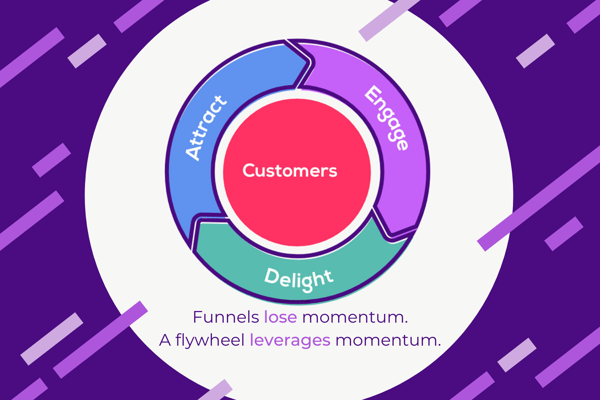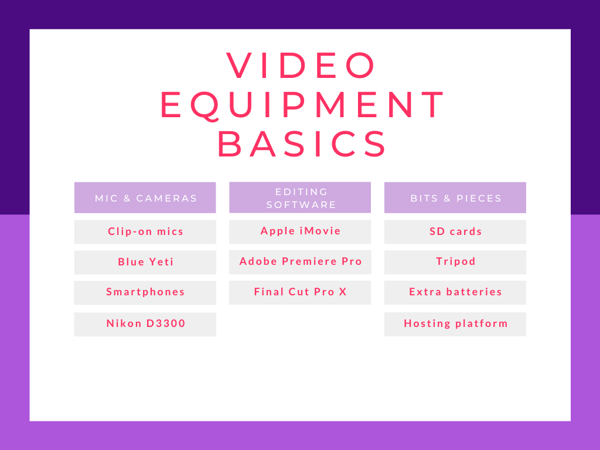The year is 2006. Google splashes out almost $2 billion to buy YouTube, the hype is real as Borat hits the big screen, Zizou does the unthinkable with a headbutt heard around the world and two blokes from MIT create a company called HubSpot that changes the way marketing works.
It was the first real step to moving away from traditional marketing methodologies. It was no longer about annoying customers and trying to force a sale. Instead, the focus shifted to gaining trust, offering helpful advice for free and attracting leads you could close over time.
So, those two blokes, Brian Halligan and Dharmesh Shah, coined the term inbound marketing. It was a fresh, new way to solve pain points and marketing challenges. But as you’d expect, a fair bit has changed since 2006 and although the key principles remain the same, inbound marketing has grown to become unrecognisable from what it was when it first hit the scene.
However, simply knowing this method is quite different from creating an effective inbound marketing strategy that actually gets you the results you need. That’s why I’ve created this one-stop guide, so you know exactly what to do and what to avoid when it comes to developing a strategy that actually works.
One key bit of advice before you dive in: the more effort you put into each step of your strategy, the more you’ll get out.
- A quick refresher on inbound marketing.
- Work on your goals.
- Replace your funnel with the flywheel.
- Refine your buyer personas.
- Map out the buyer’s journey.
- Craft your engaging content strategy.
- Improve your SEO.
- Don’t neglect your social media channels.
- Boost your website’s marketing efforts with Growth-Driven Design.
- Final step: how to convert all of that traffic.
A quick refresher on inbound marketing.
Inbound marketing is a way to gain the trust of would-be customers by giving them free insight and advice. When they’re ready to buy, they’re more likely to already trust your business. The difference between inbound and outbound is the former addresses people’s problems and pain points, while the latter can be considered intrusive.
So, by helping people in their search, you attract qualified prospects that trust your business. Through inbound content and all your inbound marketing efforts, you’ll generate quality leads that pull people towards your company. Once you give out helpful information and attract inbound traffic, you can eventually convert, close and delight them.
How-to guides, blogs, case studies...all of these types of content aim to solve problems for internet users searching for information which helps them at their own particular stage of the buyer’s journey. Eventually, your inbound marketing strategy will provide enough content to cover all scenarios and earn enough trust to win a lead’s business.
That’s just the tip of the iceberg. You need to think about things like social media, SEO, PPC and more. To gain a much better understanding, check out and bookmark this ultimate guide to inbound marketing which covers every aspect of this technique.
Work on your goals.
Whether you’re at that exciting stage of planning your first-ever inbound marketing strategy or you’re a veteran and want to tweak it for even better results, don’t neglect your goals. It’s simple, but setting goals is a massive part of inbound marketing yet many fail to do it effectively.

Think about your targets last quarter and whether you hit them. Did you convert as many leads as you planned? How many sales did you get? Make sure when you plan your strategy, you set goals you can achieve and establish them so your entire team knows what they’re contributing to.
When setting the goals you want to achieve through your inbound marketing strategy, make sure your goals are SMART. That means every goal you set should be…
Specific
The more specific you make your goals, the more focused your work towards them can be. If your goals are vague then it’s hard to know whether you actually achieved them or not. So for each goal, make sure you know who’s working towards it, what you’re hoping to achieve and when you think you’ll complete the goal.
Don’t just finalise one big goal either. Depending on its size and how long it’ll take to complete, you might find it beneficial to have some smaller key objectives to meet along the way before completing the main goal.
Measurable
Each goal you have, it needs to feature milestones which you can measure. The key metrics within signify how well you’re progressing towards the goal. Whether you want to monitor social media followers, blog views, the number of SQLs - make sure you find a metric you can measure for whatever your goal is.
Attainable
There’s nothing wrong with being ambitious and aiming high but be honest with yourself. If a goal sounds unrealistic and doesn’t seem achievable, you’re at risk of failing and disheartening your team. If you have an email open rate of 10% right now, then setting your next goal to 80% probably isn’t as realistic as 15% or 20%.
Move on to bigger targets when you can chip away at those smaller goals consistently.
Relevant
If you set goals that don’t positively impact your business right now, they’re probably best left alone. If your biggest challenge right now is sales, for example, then your time should be spent on goals that directly impact those challenges and help overcome them.
Sure, focusing on gaining a few hundred or thousand extra followers on your social channels is a great goal, but it probably wouldn’t be your biggest focus if you’re trying to boost sales right now.
Timely
You need to have long-term goals, that’s a given. Although, it’s a good idea to also create some goals that are more time-sensitive. Not only does it give you the motivation to work towards completing the goal successfully, but it also reduces the chances of becoming complacent.
Plus, it’s always good to tick off timely goals so you stay proactive. By creating SMART goals to achieve using your new inbound marketing strategy, you have a better chance at driving growth where everyone’s on the same page.
Replace your funnel with the flywheel.
The traditional marketing funnel might be your trusted sidekick which you’ve relied on for years. But to develop an effective inbound marketing strategy, it’s time you said your goodbyes, kick the funnel out and let the flywheel move in. This is a huge part of how you’ll develop your strategy and the results you’ll see.
Think about it. With a marketing funnel, it loses the energy you put into it once you reach the bottom. Where does a lead go from there? What are their next steps? Basically, the customer is an afterthought and that’s not how it should be. The linear approach to measuring growth isn’t a strong point. Sure, it produces customers but the funnel doesn’t take into consideration how those customers help you grow.
The funnel doesn’t cater to customers. It only focuses on getting them and ignoring how they can help is a huge detriment, especially since word of mouth is arguably one of the best fundamentals to great marketing.
With the flywheel, however, customers are at the centre. While funnels lose their energy at the bottom, flywheels leverage momentum to keep spinning. So to begin, you attract people to your business with your brilliant inbound marketing efforts. This is what gets the flywheel spinning.
If the friction during the journey from marketing content to sales conversions is minimal, there’s plenty of energy being harnessed by the flywheel, allowing it to pick up pace. Then once there’s a sale, don’t forget to delight customers as the flywheel is a process where these customers feed your growth.

Happier customers stay with you longer. These loyal brand advocates are amazing to work with and they’ll shout about your company to whoever’s listening. This keeps the attract part of your prospect pool topped-up nicely and they already partly trust you.
For a more in-depth breakdown of the flywheel in action, check out this blog post. Or if I wasn’t convincing enough to make you part ways with your beloved funnel, maybe Brian Halligan’s talk on it during his keynote at INBOUND 18 will change your mind. (Yes, it’s almost two years old so don’t waste more time making the switch).
And for a super-easy way to digest the flywheel, check out our podcast below with Jon Dick, the Vice President of Marketing at HubSpot.
Refine your buyer personas.
As tempting as it can be to dive in and create engaging content, you need to work on your buyer personas first. These are semi-fictional portrayals of your best or ideal customers. By collecting and using information about your target market, you can create detailed profiles of the types of customers you’ll deal with.
By understanding their ambitions, attitudes and priorities, only then can you create content that will truly engage with him. I know, it can be tempting to rush this research process or even try your luck without one, but you shouldn’t rush this process and yes, you do need personas. Spend enough time making sure your personas are accurate and thorough.
Having thorough personas means you can better understand your market which can lead to improved conversion rates. By skipping this process entirely or not being detailed enough, you’re at risk of creating content nobody reads, attracting the wrong people and wasting your budget on irrelevant tactics.
You don’t need to go overboard, though. You’re making a complete profile of a small number of your customers so around three personas should be enough. The content of these personas is based on you or your client’s own experience, what you know about current customers, third-party research and if you can, interviewing current and potential customers.
Along with defining their interest, demographic and behaviour, they’re useful in identifying their decision-making style. When it comes to drafting up your personas, here are some things to identify and document:
- Their roles and responsibilities.
- Their challenges.
- The goals they want to achieve.
- The pain points they face.
- How they discover and learn new things, such as blogs, videos, TV, social media habits and more.
- Any objections they’d have to your product, service or brand.
Knowing exactly who you’re marketing to is what makes inbound marketing campaigns more effective, rather than trying your luck and seeing what works. By creating your buyer personas, your campaigns will actually resonate with your audience and capture the right-fit customers.

If you’re struggling with where to start, we’ve got some handy templates to help you out. They’re totally customisable and include everything I mentioned above - from job titles and responsibilities to goals and pain points. Whatever you need to create clear, detailed and well-formatted buyer personas, it’s all in the template pack below.
Once you’ve spent some time defining your buyer personas, the next part of your inbound marketing strategy revolves around understanding the journey they’ll take.
Map out the buyer’s journey.
The buyer’s journey is a process where individuals become aware of a problem, they consider and evaluate their options before deciding to purchase a product or service. Their behaviour has changed and now they hold all of the power - not the seller. It’s mainly because everybody has a world of information at their fingertips through their smartphone, so buyers are more educated than ever before.
When you last bought a new smartphone, found a new restaurant to try or hotel to stay at, it’s likely you’d have done a lot of research with all of your options recommending themselves. Reviews, technical information, menus and everything else available on the internet, ultimately, influence your decision.
So, the power of a quick Google search has changed the buyer’s journey. For a truly effective inbound marketing strategy, you need to target all four stages of the buyer’s journey otherwise you won’t generate enough leads. If you don’t plan content which addresses each stage or neglect it entirely, those leads will find content elsewhere and be marketed to by your competition.
If you don’t know which type of content works best at which stage, don’t worry. Here’s a breakdown on the content you should produce to cover every area of the buyer’s journey.
Awareness
Here, the individual realises they have a problem and it’s why they’re searching for a solution. The key thing here is to not promote your brand as right now, they’d have zero interest. They just need a definition of their symptoms, so throw a truckload of useful content at them to nudge them to the next stage.
- Thought leadership eBooks.
- Educational blogs.
- Industry reports and analysis.
- Downloadable guides.
- Troubleshooting tips.
- Infographics.
Consideration
Once the individual has defined the problem, they now want to understand what the best product or service is to help them solve the issue. They’d still be fairly uninterested in you right now - they just want to work through a list of solutions.
- Podcasts.
- Webinars.
- How-to videos.
- Online Q&As.
- Technical blogs.
- Expert eBooks with actionable steps.
- Downloadable tools.
Decision
Now, the buyer has picked a solution. They know how to solve their problem, they’ve researched specific products and services and they’re going to whittle their options down to a list. Ultimately, it’s to make a purchase decision. If you’ve created engaging content in the previous two stages, they’re far more likely to trust you.
Oh, and you can finally shout about your brand messaging and detailed information about your processes.
- Free trials.
- Demos.
- Competitor comparisons.
- Client case studies.
- Product datasheets.
- Price guides.
- Service level agreements.
Delight
Remember the bit where I said it’s time to part ways with the funnel and embrace the flywheel? This is where it’s most relevant. At the delight stage, you should exceed a customer’s expectations to create a positive experience. Showing you’ve gone above and beyond with things like promotions, discounts and more help them become raving promoters of your brand.

By fostering this emotional connection, they’re more likely to return and be loyal to you. Delighted customers are also your best marketing asset, as they’re more likely to promote your offering to others.
- Follow-up emails.
- SMART content.
- Surveys.
- Customer spotlight downloads.
It can sound like a lot of effort before you even start creating content, but I can’t stress how much of an impact it has on the success of your strategy. So you don’t have to start from scratch, we’ve got a buyer’s journey template you can use to kickstart the process. It’s completely customisable and includes everything you’ll need to come up with content ideas that fall into the four different stages.
Craft your engaging content strategy.
Written content.
Now’s the time you can shift your focus to content. You know who your personas are, you know their pain points and you know the type of content suited to each stage of the buyer’s journey.
Using tools like Moz and SEMrush, you can find keywords you want to target and eventually rank for on search engines like Google. So, your blog titles and content need to include those keywords. Although, they should be seen as secondary to the main aim of blogging.
The main point of blogging as part of an effective inbound marketing strategy is to provide useful content which users will respect and enjoy. Content is where you’ll earn enough of their trust to move them along the buyer’s journey and eventually they’ll become a customer.
What’s great about creating content this way is that the traffic you get is going to be your ideal customer as the keywords are what they’re searching for and you’ve covered them. Here’s why else you need to create content:
- It drives relevant traffic.
- It converts visitors into leads.
- Content educates your readers and helps them solve problems.
- It shows you’re an authority in your industry.
- It provides long-term opportunities.
Remember, always prioritise quality information and value over red herrings and sales talk. When creating content, align it closely with your personas. This means covering aspects such as:
- Pain points - empathise with and solve them.
- Challenges - understand them and be considerate.
- Goals - how to reach them.
- Interests- be relatable.
- Research habits - they might prefer shorter content over 2,000-word blog posts or maybe even a video.
In this content planning stage, also think about how often you’re going to blog. Obviously, the more you blog, the better, but it depends on the quality of your content, the topics, relevancy, industry and audience.
Before you actually start writing content, revisit your tone of voice as well. If you’re already publishing content and you're perfectly happy with your branding and voice, that’s fine. If you’re new to it or want to switch things up, we’ve got a handy resource to help you define your brand’s tone of voice.
Finally, make sure to conduct content audits. You can’t let this slip under the radar either. Let’s say you’re pushing out hundreds of decision pieces. That’s great. You’re pushing out content. But you might not realise that 99% of your website’s content is all decision-based stuff that can scare readers away, especially those at the start of the buyer’s journey.
With an audit, you can see where the gaps are which you need to fill. It'll help you to identify which pieces work well and can be repurposed and which just don’t add value any more. This helps to ensure readers don’t stop engaging with your brand and they don’t end up on a competitor’s website.
Our all-in-one guide to inbound marketing has a great section on content marketing you should check out. Once you’ve done that, click the button below to get your very own content audit template to get started on only creating relevant content.
All you need to do is fill out the existing content you have currently and map out some new ideas. We’ve also included a summary of each state so you can see if your ideas match.
Video content.
Thought that was it for your content marketing efforts? You could stop there but for your strategy to really make a huge impact, don’t neglect video. Need some proof? Check out these which should give you a better idea of why you need to take advantage of the video hype.
- More than 50% of customers want to see videos from their favourite brands.
- 82% of all internet traffic is expected to be video by 2021.
- Just by including video in the subject line of your email, you can see a 19% increase in open rates. Click-through rates (CTR) can also see a 65% jump.
- 87% of marketers are already using video as a marketing tool.
- Video marketers get 66% more qualified leads per year.
I could sit here all day and list why you need to invest in video marketing but rather than doing that, here’s how to create an effective strategy instead. For starters, it all depends on your existing content, kind of how you’d conduct a content audit to see what you have and where the gaps are.
The beauty is you can use video for anything. Social snippet to increase interactions. Podcasts. Stick it on a landing page to explain what’s on there. Convert a blog post into a digestible video. Delight customers with case studies. Anything.

The principle is the same as a normal content audit. By seeing which videos you have or where you can add videos, you can increase chances of conversion. Talking heads on a webpage is a great start and who knows, one day you might film a full production case study or TV ad. For starters, though, even something as simple as a screen recording is a good way to start improving conversion rates.
The fact is, you can’t produce millions of videos at once. You might not have all the equipment or your budget might be limited. So in your strategy, turn to things like explainer videos to bring in traffic and use video to convert more prospects and also nurture them in the sales process.
That’s something we did at Digital 22. An explainer video on how much AdWords costs helped us get into the rich snippet on Google and brought in plenty of traffic and at the opposite end of the spectrum, an animated video helped us launch a brand.
Set appropriate goals as well, just like you would in your overall inbound marketing strategy. Sometimes, even a click on a page is a great achievement as video is now so disposable. The key thing to remember is a video on its own can’t make someone a customer, but it can play a big role in helping nudge them over the line.
To measure success, think along the lines of play rate. This is the percentage of people pressing play. Then, monitor attention to see where to put the CTA and also measure the CTA CTR to see if you need to make any adjustments. To help you get a head start, here’s some basic equipment you can get your hands on.
- A camera - Smartphones are a good start while the Nikon D3300 is a higher-end option.
- Microphone - You can’t go wrong with some clip-on mics from Amazon or for something a little better, check out the Blue Yeti.
- Editing software - Apple iMovie and Adobe Premiere Pro are two go-to options.
- Some extra bits and pieces - SD cards, a tripod, lighting, extra batteries, screen recording software and a host site such as YouTube, Wistia and Vidyard.
Inbound video is a different beast to tackle in itself. I can’t do it justice right here, but we do have some excellent resources I recommend you check out. This ultimate guide to inbound video is the perfect starting point. It takes you from what it is, where you can use video, right through to executing your own video shoot.

We’ve also got a bunch of blogs dedicated to video here.
Or if you want to live through your very own Inception and watch videos about videos, we recently launched Inbound U. It’s an online university where you can get certified for learning about inbound video and how to develop your strategy further with some tried and tested tips. Get access using the link below.
Improve your SEO.
The next part of developing your effective inbound strategy is to focus your efforts on SEO. With more businesses now online, search engines are vast places and with SEO, you maximise your chances of customers finding you when they search for a product or service.

However, it’s more than just stuffing your content with matching keywords people type into search engines. Investing in SEO makes sure every aspect of your website is well-tuned and helps your business succeed online. That’s why you tend to find businesses turn to agencies as they have the experience and resources to get the job done.
If you do have some spare time, there are some basics you can learn to do some of your own website maintenance. Here’s how:
- Do some research to find the best keywords to describe your business. These keywords will be essential for the content you write for your website.
- Improve your SEO by including your keywords in your meta titles and descriptions. These refer to the title and description of each individual page of your website.
- The content on your website pages should include keywords to help search engines like Google what your website is about.
- A link from one website to another is seen as a ’vote’ or recommendation in the eyes of a search engine. So if a website has a lot of recommendations, it appears higher on the results page.
As part of your strategy, also look into tools such as Moz and SEMrush for more detailed SEO metrics. To help make the SEO side of things even more effective as part of your wider inbound marketing strategy, here’s another checklist you can use to help give your website the best possible start.
- Ensure analytics tracking is in place.
- Make sure there aren’t multiple versions of the same website.
- Ensure the URLS are search engine friendly.
- Your website should include a robots.txt file.
- Upload an XML sitemap into the root folder.
- Focus on page title tags.
- Optimise your meta description titles to feature keywords.
- Use keywords within a series of headings and subheadings.
- Support each heading with quality content.
- Don’t ignore alt tags when adding images to your website.
- Anchor link keywords when linking internally.
- Consider your page loading times.
Once you’ve covered the basic, take your strategy up a level by focusing on some bigger items with the following tips:
- Content for link building: Research and visualisation, create tools and write valuable resources or guides.
- Content for internal content: Differences between brands, highlight the different options available, price comparisons and aftercare instructions.
- Social media and social content: Webinars, how-to guides, games competitions, reviews, demos and FAQ’s.
- PR: Overview of the company, proof that you’re experts and resources.
Like anything in inbound marketing, you shouldn’t rush or half-arse anything. Otherwise, it could impact your results. To help with your strategy even more, check out this blog from Digital 22 Founder and Director, Rikki, on how you can take your SEO to the next level.
Don’t neglect your social media channels.
This one is fairly obvious, but you still need to do the behind-the-scenes work properly for your strategy efforts to pay off. You need social media accounts for people to view your content as they're your means of getting content out there. Social media allows you to get cold leads and reach a new audience before the slow-burn SEO can really work its magic.
This is where you need to whip out your well-researched personas again (hence making sure you don’t rush them) to make sure everything you social share is on the right networks, you send it at the right time and in the correct tone.
When you know what your audience likes, what they’re discussing and searching, then you can create more content which satisfies their needs. Combining all of this helps you become a part of the conversation and build yourself up as a leader within your industry on social media. So, here are some things to watch out for when refining your social media strategy:
- Don’t spam your account with constant, repetitive or automated posting.
- Don’t leave your accounts unmonitored.
- Don’t forget to optimise your account for the particular campaign you’re running.
- Don’t be afraid to experiment a little.
The tricky thing with a social strategy is I can’t tell you exactly what to do. It depends on your personas, your resources, the channels you use and more. What I can do is offer a rough plan we’ve followed to help set you on your way.
- Post content on relevant networks with the following frequency;
- On publish: Twitter, Facebook and LinkedIn (if suitable).
- Later that day: Twitter.
- The day after: Twitter.
- The same week: Twitter and Facebook.
- Two weeks later: Twitter and Facebook.
- Four weeks later: Twitter, Facebook and LinkedIn. Again, this can change depending on your business as you might find your audience heavily uses Instagram.
- Post at key times of the day for each network.
- Use Instagram for day-to-day aspects of your business, such as fun posts.
- Share general ad-hoc finds on Twitter and Facebook which act as authority-building content. If you have an in-depth take, consider LinkedIn.
- Target a handful of hashtags without going overboard on Twitter.
- Stay within your tone of voice to resonate with your audience.
- Complement your sharing strategy by promoting paid posts.
Again, that’s a rough example of what your strategy could look like. If you let it gather dust for too long, you might not see any results as it’s an ever-changing game. To stay ahead of the competition, stay on top of user habits and then adapt your plans accordingly.
A bonus tip before you move on from the social media section of your inbound marketing strategy, keep changing algorithms in mind. Facebook did this a couple of years ago which had a fairly big impact with the term ‘meaningful interactions’ doing the round on social media.
When working on the social media aspect of your inbound marketing strategy, think about creating a private Facebook group for audiences to join. It’s a great way to share news, updates and information, an effective place to engage with customers and also connect with like-minded people. We did this and saw great results, so go ahead and join ours - Inbound After Hours - using the button below.
Boost your website’s marketing efforts with Growth-Driven Design.
Although you don’t need to adopt the Growth-Driven Design (GDD) methodology as part of your inbound marketing strategy, it does make sense to go down this route if you want to get the most out of your website’s marketing efforts. With GDD, you get a website that continually improves using measurable data without losing leads and customer interest.
You can break the GDD process down into three distinct phases: strategy, launch pad and continuous improvement. Here’s a bit more about each one.
- Strategy: Set SMART goals in the first 10-14 days. Understand user behaviour, solve design problems and connect with customers.
- Launch pad: Over 6-90 days, focus on prioritised improvements to launch sooner and get results faster.
- Continuous improvement: In 14 or 30-day sprints, make data-driven optimisations as your business evolves and grows for a peak performing website.
Like most things, GDD takes a lot of time and effort to understand and to do right. Although it’s pretty much impossible to touch on everything GDD-related here, you can read the entire book on it here instead. But to make sure you get enough value, here are some tips to consider when combining your inbound marketing efforts with GDD.
Design and functionality are key.
Your website needs to look professional and appealing to your ideal customers. Use simple designs, easy navigation to avoid confusing users and make sure it loads quickly.
Think about mobile.
Your website needs to look just as good on a mobile device as it does on a desktop, especially since more users are likely to use their phones to browse your website. Make sure the text is easy to read, nothing is clunked together and keep the design in mind.
CTA placement.
An appealing CTA can capture the attention of visitors. So the design of your CTA and where you place it on your website is important. Remember, consistency is key.
Clear and concise messaging.
Users will come to your website because they hope you’ll solve their pain points. Give them the content they’re searching for, offer the solution and make it clear where they can find more content.
Never stop analysing.
Analysis is important in both GDD and inbound marketing. When something doesn’t work, you pivot and switch up your tactics. Study your statistics thoroughly so you properly understand what users like and dislike.
Focus on user experience.
Both GDD and inbound marketing revolve around the user experience. The more you work on making your website one that’s worth revisiting, the more likely it is your website will be successful.
The two work hand-in-hand. Inbound marketing features all the crucial elements required to attract users to your website. On the flip side, GDD is busy dealing with the mechanics behind the scenes that help make users as loyal as possible - thanks to a perfectly tuned website.
HubSpot also recently launched the CMS Hub which is perfect for your inbound marketing and GDD needs. We’ve sat down with the Founder of GDD, Luke Summerfield, a couple of times to talk all-things web design, development and GDD. Check out the video below to hear from the man himself.
Final step: how to convert all of that traffic.
After going through all of the previous steps to accumulate traffic, now your focus needs to shift towards converting them into customers. To begin, see what content you already have and make sure it’s in line with your keyword research and buyer persona knowledge. You might find that the majority of your existing content is aimed at decision-stage users.
What you produce for each stage will be different depending on your persona’s habits, industry and services. Also, different content types can be used in multiple stages.
CTAs
Choose CTAs so best match the user’s buyer’s journey stage and context as much as possible. For example, don’t put a price guide CTA on an inspirational, awareness blog post. Instead, offer something which transcends the awareness-into-consideration stage gap.
Online support and chatbots.
With a conversational marketing strategy, you can connect with your customers on a whole new level. 80% of marketing automation users see increased leads and 77% see increased conversions. Having a chatbot on your website allows visitors to engage with you and your team whenever they want.
We also have a dedicated conversational marketing strategy resource you can look into once you’ve nailed your inbound marketing strategy. Check it out using the button below.
Paid campaigns.
Pay-per-click, PPC - whatever you want to call it, this tactic brings in quick, short-term boosts of traffic and is important for testing out the effectiveness of your copy, CTA designs and landing page effectiveness. You can also target paid ads which catch people using short-tail keywords and pick up those who are already in the decision stage.
These campaigns should always be based on the inbound keyword research you do and your buyer persona knowledge as there’s lots of scope for using PPC ads as part of your inbound strategy. Here’s what you need to know before you start using PPC in inbound.
All of this can sound like a lot to take in. However, I’ve just discussed the fundamentals of what you’d need to focus on to ensure your next inbound marketing strategy is more effective than anything you’re done in the past. To show the true impact it can have (when you put in the effort and do the strategy right), why not take a look at what a year in inbound could look like for your business?
There’s so much more to learn and help grow your own knowledge along the way. As inbound marketing has adapted over the years, so have we. Rather than work off outdated resources and plans, we’ve worked on creating a brand new guide with updated tactics, tricks and tips for you to try instead.
Develop your own effective inbound marketing strategies with Inbound 2.0.
To amplify your efforts and achieve your inbound marketing objectives, make sure you check out our new guide. You’ll build on your inbound knowledge with even more information on things like inbound processes, statistics, personas, goals and loads more.
Interested in knocking up an effective inbound marketing strategy to hit your goals out of the park? Click the link below to get started.
This blog was originally written by Paul Mortimer. It was updated in early 2020 by Molly Johnston but has since been revisited entirely to feature the most up-to-date information.
Real Growth. Real Impact.
'Should I use HubSpot?' 32 fundamental reasons why you should
21 cost-effective marketing campaigns you can create right now
Breeze: Everything you need to know about HubSpot's powerful AI
INBOUND 24 learnings and updates
Google Search API leaks: All you need to know [LIVE BLOG]
The top 6 marketing challenges of 2024
Inbound vs outbound marketing: What's the difference?
See why enterprises choose Avidly
Let’s build your HubSpot success story
Compelling final call to action - with accompanying link to Contact page





![Google Search API leaks: All you need to know [LIVE BLOG]](https://www.avidlyagency.com/hs-fs/hubfs/cloud.jpg?width=400&height=225&name=cloud.jpg)


